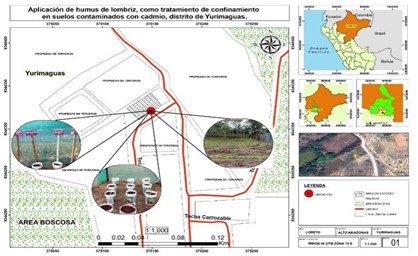Worm humus as a confining treatment for cadmium-contaminated soils in the Loreto Region, Peru
DOI:
https://doi.org/10.55996/dekamuagropec.v6i1.343Keywords:
Heavy metals, cadmium contamination, metal immobilization, Brachiaria brizanthaAbstract
Research on cadmium contamination in agricultural soils has gained significant relevance by demonstrating that organic amendments are effective in immobilizing cadmium. In this study, the species brizanta (Brachiaria brizantha), a grass used in livestock activities, was selected and studied as a phytoremediation plant. The objective was to evaluate the effectiveness of earthworm humus in the remediation of cadmium contaminated soils, using Brachiaria brizantha as a biological indicator in the city of Yurimaguas. For the method, a randomized experiment was designed with four treatments: a control without humus (T0) and three doses of worm humus (T1: 5000g/m², T2: 10000g/m², T3: 15000g/m²) in soils with 1.5 ppm of cadmium. Plant growth and cadmium concentrations were monitored for four months. The results showed that T3 retained more cadmium in the soil (0.4467 mg/kg), while T2 and T0 presented greater accumulation in the plants (1.3367 mg/kg and 1.0367 mg/kg, respectively). A significant negative correlation was observed between cadmium in soil and plant (r=-0.714, p=0.009), and although there were no significant differences in growth, the relationship between cadmium in plant and dry weight (r=-0.620, p=0.031) suggests phytotoxic effects. It is concluded that vermicompost can modify the bioavailability of cadmium, offering a viable alternative for the remediation of soils contaminated with heavy metals. Likewise, the correlation of cadmium in the plant and dry weight does not significantly influence, indicating that as dry weight increases, the cadmium concentration of the plant decreases.
Downloads
References
Abdolali, A., Ngo, H. H., Guo, W., Zhou, J. L., Du, B., Wei, Q., Wang, X. C., & Nguyen, P. D. (2015). Characterization of a multi-metal binding biosorbent: Chemical modification and desorption studies. Bioresource Technology, 193, 477–487. https://doi.org/10.1016/j.biortech.2015.06.123
Almerco, P., Galvan, L., & Yañac, C. (2023). Humus de lombriz como alternativa en la recuperación de suelos contaminados con metales pesados en la Compañía Minera Argentum-2023.
Blouin, M., Barrere, J., Meyer, N., Lartigue, S., Barot, S., & Mathieu, J. (2019). Vermicompost significantly affects plant growth. A meta-analysis. Agronomy for Sustainable Development, 39(4), 34. https://doi.org/10.1007/s13593-019-0579-x
Bustamante Carrión, M. E. (2018). Efecto de la aplicación de estiércol de lombriz en la disponibilidad de arsénico y cromo, en un cultivo de maíz del distrito de Orcotuna, Concepción - 2016. In Universidad Continental. https://repositorio.continental.edu.pe/handle/20.500.12394/4650
Castaldi, P., Santona, L., & Melis, P. (2005). Heavy metal immobilization by chemical amendments in a polluted soil and influence on white lupin growth. Chemosphere, 60(3), 365–371. https://doi.org/10.1016/j.chemosphere.2004.11.098
Cheng, Q., Lu, C., Shen, H., Yang, Y., & Chen, H. (2021). The dual beneficial effects of vermiremediation: Reducing soil bioavailability of cadmium (Cd) and improving soil fertility by earthworm (Eisenia fetida) modified by seasonality. Science of The Total Environment, 755, 142631. https://doi.org/10.1016/j.scitotenv.2020.142631
Farnezi, M. M. de M., Silva, E. de B., Santos, L. L. dos, Silva, A. C., Grazziotti, P. H., Alleoni, L. R. F., Silva, W. C., Santos, A. A., Alves, F. A. F., Bezerra, I. R. S., & Miranda, L. C. (2022). Potential of Forage Grasses in Phytoremediation of Lead through Production of Phytoliths in Contaminated Soils. Land, 12(1), 62. https://doi.org/10.3390/land12010062
Furcal-Beriguete, P., & Torres-Morales, J. L. (2020). Determinación de concentraciones de cadmio en plantaciones de Theobroma cacao L. en Costa Rica. Revista Tecnología En Marcha. https://doi.org/10.18845/tm.v33i1.5027
Gravand, F., Rahnavard, A., & Pour, G. M. (2021). Investigation of Vetiver Grass Capability in Phytoremediation of Contaminated Soils with Heavy Metals (Pb, Cd, Mn, and Ni). Soil and Sediment Contamination: An International Journal, 30(2), 163–186. https://doi.org/10.1080/15320383.2020.1819959
Huaraca-Fernandez, J. N., Pérez-Sosa, L., Bustinza-Cabala, L. S., & Pampa-Quispe, N. B. (2020). Enmiendas orgánicas en la inmovilización de cadmio en suelos agrícolas contaminados: una revisión. Información Tecnológica, 31(4), 139–152. https://doi.org/10.4067/S0718-07642020000400139
Lwin, C. S., Seo, B.-H., Kim, H.-U., Owens, G., & Kim, K.-R. (2018). Application of soil amendments to contaminated soils for heavy metal immobilization and improved soil quality—a critical review. Soil Science and Plant Nutrition, 64(2), 156–167. https://doi.org/10.1080/00380768.2018.1440938
Manjarrez-Paba, G., Castro, I., & Utria, L. (2008). Bioacumulación de cadmio en ostras de la bahía de Cartagena. Revista de Ingenierías: Universidad de Medellín, 7(13), 11–20. www.cep.
Munive, R., Gamarra, G., Munive, Y., Puertas, F., Valdiviezo, L., & Cabello, R. (2020). Lead and cadmium uptake by sunflower from contaminated soil and remediated with organic amendments in the form of compost and vermicompost. Scientia Agropecuaria, 11(2), 177–186. https://doi.org/10.17268/sci.agropecu.2020.02.04
Munive, R., Loli, O., Azabache, A., & Gamarra, G. (2018). Phytoremediation with corn (Zea mays L.) and Stevia compost on soils degraded by contamination with heavy metals. Scientia Agropecuaria, 9(4), 551–560. https://doi.org/10.17268/sci.agropecu.2018.04.11
Palansooriya, K. N., Shaheen, S. M., Chen, S. S., Tsang, D. C. W., Hashimoto, Y., Hou, D., Bolan, N. S., Rinklebe, J., & Ok, Y. S. (2020). Soil amendments for immobilization of potentially toxic elements in contaminated soils: A critical review. Environment International, 134, 105046. https://doi.org/10.1016/j.envint.2019.105046
Park, J. H., Lamb, D., Paneerselvam, P., Choppala, G., Bolan, N., & Chung, J.-W. (2011). Role of organic amendments on enhanced bioremediation of heavy metal(loid) contaminated soils. Journal of Hazardous Materials, 185(2–3), 549–574. https://doi.org/10.1016/j.jhazmat.2010.09.082
Peña, K., Carrillo, M., Durango, W., Orozco, P., & Peña, A. (2021). Mitigacion de Cadmio por fitorremediacion. https://balcon.
Pérego, J. L. (1999). Brachiaria brizantha, implantación, manejo y producción. Producción Animal, 1–5.
Poma Jimenez, A. A., & Quiñonez Rojas, C. E. (2021). Efecto de enmiendas orgánicas en la fitorremediación con Zea mays l. en un suelo contaminado con cadmio. Leonor Ordoñez, Jauja - 2021. In Repositorio Institucional - UC, Cusco - Perú, Tesis de pregrado.
Wang, F., Wang, X., & Song, N. (2021). Biochar and vermicompost improve the soil properties and the yield and quality of cucumber (Cucumis sativus L.) grown in plastic shed soil continuously cropped for different years. Agriculture, Ecosystems & Environment, 315, 107425. https://doi.org/10.1016/j.agee.2021.107425
Zhang, D., Li, T., & Wang, Y. (2022). Effects of Soil Amendments Applied on Cd and Pb Immobilization and Environmental Risks under Simulated Acid Rain. Polish Journal of Environmental Studies, 31(5), 4953–4963. https://doi.org/10.15244/pjoes/149712

Downloads
Published
How to Cite
Issue
Section
License
Copyright (c) 2025 Kiara Melissa Ríos Paima, Andrés Erick Gonzales López

This work is licensed under a Creative Commons Attribution 4.0 International License.
Los autores que publican en esta revista aceptan los siguientes términos:
- Los autores conservan los derechos de autor y conceden a la revista el derecho publicación con la obra, simultáneamente licenciada bajo una licencia de Creative Commons CC By que permite a otros compartir el trabajo, pero citando la publicación inicial en esta revista.
- Los autores pueden celebrar acuerdos contractuales adicionales separados para la distribución no exclusiva de la versión publicada de la obra de la revista (por ejemplo, publicarla en un repositorio institucional o publicarla en un libro), pero citando la publicación inicial en esta revista.
- Se permite y anima a los autores a publicar su trabajo en línea (por ejemplo, en repositorios institucionales o en su sitio web) antes y durante el proceso de presentación, ya que puede conducir a intercambios productivos, así como una mayor citación del trabajo publicado (https://web-archive.southampton.ac.uk/opcit.eprints.org/oacitation-biblio.html)














